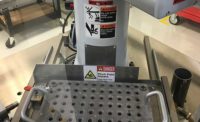“Always use the right tool for the job.” The old adage is applicable whether you’re talking about a hand tool or something as sophisticated as an industrial robot.
When putting together an automated assembly line for a medical device manufacturer, systems integrator Automationnth faced conflicting requirements. Some operations required a high degree of precision; others simply needed speed. Picking the right robot for each task saved the customer money without compromising performance.
“When manufacturers come to us with automation needs, it’s important for us to deeply understand their strategy and requirements,” says Greg Young, vice president of business administration at Automationnth, which has offices in LaVergne, TN, and Poway, CA. “They could be transitioning from manual production to automation, or they might need to scale quickly. We help them go from a blank sheet of paper to complex automated assembly by working together to find the best solution that meets their long-term objectives. We also help maintain that equipment after it’s in production.”
Founded in 1999, Automationnth has established itself as a market expert in medical device assembly applications.
“During one of our consultations with a medical device company, we came across a unique and challenging manufacturing problem,” says Jeff Buck, vice president of engineering at Automationnth. “Not only did we need to provide high-precision and high-performance robots on the front of the line, but we also needed time and cost-efficient robots on the end of the line.”
Precision Where It Counts
For Automationnth, Epson was a natural choice to meet the all needs of this assembly system. An Epson customer since 2017 and a member of Epson’s AutomateElite authorized system integrator program, Automationnth knew the robot maker offered a wide range of products for small-parts assembly.
“A particular application that we developed for this customer required super high precision. We were looking for a robot that had ultra-high precision capabilities,” says Buck. “We found the Epson G-Series, and that’s why we picked Epson.”
Epson G-Series SCARA robots feature a high-rigidity arm design that delivers high speed, high precision and low vibration. The line-up offers a maximum reach of 175 to 1,000 millimeters and a maximum payload of 1 to 20 kilograms. The robot can perform a standard pick-and-place move—1 inch up, 12 inches across and 1 inch down—in just 0.29 second.
“With the G-Series, we were able to provide vision feedback to provide offset settings back to the robot,” says Buck. “This helped us establish an industry standard by which Epson robots are now widely used across many key life sciences manufacturers.”
For this particular application, the final product was the size a quarter. Its individual components were very small, indeed. The parts had insertion tolerances of 20 microns in the X and Y axes and 1.5 degrees of angular rotation. The robot would need to move with an accuracy of ±5 microns. Automationnth created a parts feeding system that used Epson G-Series robots to identify and handle different components that were barely visible to the human eye.
The company also employed its Flexbase configurable, modular platform for automation. Flexbase enables manufacturers to standardize production equipment, simplify engineering and maintenance, and adapt quickly to changing production requirements. It also provides a lower-risk path to transition manual processes to semiautomatic or fully automated processes. Flexbase can be used for a variety of processes including assembly, sorting, testing, handling, fastening and joining.
Available in standard 4- or 6-foot-wide models, Flexbase can be configured as a standalone automated workstation or linked together to quickly create a complete production line. Optional conveyors can be configured with over-under pallet recirculation.
Flexbase is ISO 6 compliant and can be FDA validated with a documentation package. It has a maximum height of 7 feet, 6 inches to fit through a standard 8-foot doorway and includes built-in levelers. It is also ergonomically designed to accommodate a standing or sitting operator.
For this assembly, Automationnth needed to pick up components from various feeding systems, including a reel, a feeder bay and a tray with an escapement. The parts would then be inserted into the assembly, explains Buck.
Simplicity on the Back End
For processes at the back end of the assembly line, which did not require as much precision, Automationnth integrated Epson’s T-Series All-in-One SCARAs, which offer industrial performance at a more cost-effective price.
Priced 30 to 50 percent less than conventional SCARAs, these compact robots are positioned to compete head-to-head with Cartesian robots.
The controller is built into the robot’s base, so there’s no need for a separate control cabinet or control box. There are no cables to run from the controller to the robot. A short cable duct on top of the robot also contributes to the overall compactness.
With the controller built in, setup and deployment are faster and easier. To set up the T3, engineers simply mount the robot to a tabletop, attach the end-of-arm tool, and plug it in. After programming the robot through an intuitive user interface, the robot is ready for work.
An on-board I/O communications port adds to the all-in-one functionality. This provides a direct connection to the controller and includes power for the end-of-arm tooling, making it easier to connect cables to the end effector and supply power to it.
For applications requiring vision, the robot is already equipped to seamlessly integrate with an object-based, point-and-click interface for vision guidance. Using the integrated vision system allows all development to be done from one environment, thus reducing overall development and configuration time.
With reach distances of 400 and 600 millimeters, the T-Series can handle payloads of 3 and 6 kilograms, respectively.
Using a variety of automation equipment enabled Automationnth engineers to deliver the best combination of functionality and price.
“For the scope of this program, we were able to easily install a range of Epson robots—18 from the G-Series and 21 from the T-Series for each line. With six lines altogether, that’s 234 robots,” shares Young.
Programming all those robots could have been a chore, but Epson’s user-friendly RC+ programming environment made the job easy. The software allows all components to communicate on a single platform. “It allowed us to interface with the Epson robots using a template code that that we developed,” says Buck.
Ultimately, the medical device manufacturer was pleased with the automated production line, which provided better quality and faster cycle time than manual assembly.
“Our customer is very happy because they were able to successfully execute one of the fastest production ramps the industry has seen,” says Young. “They are now producing millions of units per year, while also improving their yield and product quality. This also resulted in less product warranty exposure.”





